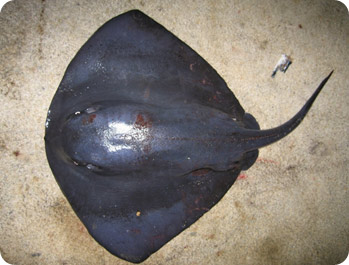Radio Program
Our regular Science and the SeaTM radio program presents marine science topics in an engaging two-minute story format. Our script writers gather ideas for the radio program from the University of Texas Marine Science Institute's researchers and from our very popular college class, Introduction to Oceanography, which we teach to hundreds of non-science majors at The University of Texas at Austin every year. Our radio programs are distributed at to commercial and public radio stations across the country.
At the bottom of almost any ocean, you’ll find an assortment of creatures with small disk-like bodies and five gangly arms: brittle stars. They’re described as among the most “cosmopolitan” creatures in the sea, because they’re found around the world -- from the Arctic and Antarctic to the tropics.
In the early 1800s, much of the economy of the infant United States depended on the sea -- fishing, whaling, and international trade. Yet sailing into American harbors could be tricky, because there were few good charts of hidden reefs and other obstructions -- or even of the coastline itself. So in 1807, Congress created a new agency -- the Survey of the Coast -- to map the entire coastline.
One of the world’s longest mountain ranges twists it way down the center of the Atlantic Ocean -- the Mid-Atlantic Ridge. Its peaks can tower up to two miles high, and they’re separated by steep-sided canyons. The ridge marks the boundary between oceanic plates, where hot rock is pushing up from far below the ocean floor to make new crust.
After the Titanic sank in 1912, world shipping powers began a program to find and track icebergs, and keep ships well informed of their positions. The program has saved countless lives. It’s also helped oceanographers learn more about them.
To qualify as an iceberg, a chunk of ice must be at least 50 feet long, and stand about 17 feet above the surface. Even such a minimal berg would be huge, though, because almost 90 percent of an iceberg’s body is below the surface.
Humans aren’t the only mammals to use nets when they go fishing. Some humpback whales do it, too. But their nets are made of bubbles. The humpbacks swim in circles, blasting air through their blowholes.
This creates a “net” of bubbles that traps krill and fish inside. The whale then swims up through the middle of the net, opens its jaws, and traps hundreds of pounds of food at a single gulp.
The unusual fishing technique is only one feature that attracts scientists and the rest of us to these giant creatures. Another is their songs.
A tongue-in-cheek study a few years ago found that Kansas is flatter than a pancake. For their next work, the geographers who compared the two might want to study the ocean floor. Great stretches of it, called abyssal plains, are the flattest places on Earth.
A tongue-in-cheek study a few years ago found that Kansas is flatter than a pancake. For their next work, the geographers who compared the two might want to study the ocean floor. Great stretches of it, called abyssal plains, are the flattest places on Earth.
{mosimage}
When Steve Irwin died from the jab of a stingray last year, it made headlines around the world. TV’s “Crocodile Hunter” died after the venomous barb punctured his heart.
 Despite the hoopla, stingrays don’t attack people that often. They’re usually pretty shy. They hang out in the sand on the ocean floor, feeding on clams and other bottom dwellers. They use their stingers only for defense.
Despite the hoopla, stingrays don’t attack people that often. They’re usually pretty shy. They hang out in the sand on the ocean floor, feeding on clams and other bottom dwellers. They use their stingers only for defense.
When Steve Irwin died from the jab of a stingray last year, it made headlines around the world. TV’s “Crocodile Hunter” died after the venomous barb punctured his heart.
{mosimage}
Like the fire-breathing monster for which it’s named, a jagged tower of rock and metal named Godzilla rose high above the ocean floor -- more than 15 stories. A jet of scalding water blasted from its top. And not even decapitation could stop it: After its top two-thirds fell over, it kept on jetting black water, and quickly began rebuilding itself -- a process that continues today.



